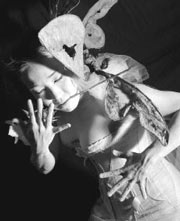NYMPH
Degenerate Art Ensemble On the Boards, 100 W. Roy, 217-9888, $8-$18 8 p.m. Thurs., April 18-Sun., April 21
SINCE ITS FOUNDING in 1994 as the Young Composers Collective, the Degenerate Art Ensemble has evolved from its origin as a new-music chamber orchestra toward a unique mix of Butoh-inspired, intensely dreamlike performance art— a sort of nonvocal opera. Nymph, which opens next week, is the group’s most ambitious piece yet, a plotless but theatrical combination of movement, live music, and video for four dancers and seven musicians, who are asked to move and act as well as play their instruments. Composer Joshua Kohl says Nymph is “by far the most integrated music/ theater/dance work we have ever made.”
The group’s choreographer/ dancer, Haruko Nishimura, says the piece brings together the natural world—”nymph” designating a larval stage of insect development—and the same world’s supernatural, fairy-tale connotations, which are given a sinister spin typical of the DAE’s work. “I heard from someone,” she explains, “that European people used to hang scissors in the windowsill or around the baby’s crib or in the doorways to capture the fairies or the bad spirits coming in. It’s the weirdest, creepiest, most beautiful image.” These scissor evocations find their way into the music as well; Kohl describes Nymph as “a dark tale of a boy’s dizzying encounter with the spirits and creatures of his inner world, a world full of whispers and the sounds of cutting.”
The DAE’s theater pieces often combine beauty and grotesquerie—or more precisely, explore their common ground. In Nymph, Nishimura seeks to address these concepts from a female perspective: “I’d been doing a lot of Butoh and experimental movement pieces, and one day I looked up. . . and it was all male energy—extremely aggressive testosterone energy, so I wanted to explore the female energy. . . . A woman giving birth, it’s so intense and sweaty and bloody, there’s some beauty in that. The image of a struggle is beautiful.”
The show’s slowly taken shape over the past year, including a run in Berlin last October—13 shows in three weeks, each one sold out. There, it was staged in a smaller theater, so the DAE has scaled it up for the On the Boards run, adding three more dancers in addition to Nishimura and building a tri-level 14- by 36-foot industrial-scaffold set for the musician/actors.
From the start, the musicians were asked to improvise the live score that accompanies Nishimura’s movement. In each rehearsal and each performance, the musicians take the strongest ideas they’ve already discovered and build further on them. Initially reluctant—or “panicked,” as he puts it—to forgo the security of a score that was fully written out from the start, Kohl warmed to the concept of perpetually making up Nymph‘s music as they went along: “You improvise, as eight people, this interesting orchestration that lasts for three seconds and then goes into gibberish. You capture that interesting thing, you stretch it and refine it, you memorize it—and then you start improvising on it again, so you’ve got that as a new, very focused improvisational structure.”
Not only did the musicians improvise the score, but they invented new instruments to do it with, increasing their stock of disturbing, hallucinatory sounds to match Nishimura’s stage images: amplified metal cables stretched across the scaffolding and stroked or struck; “torture horns” made of lengths of PVC pipe with bagpipe reeds inserted. Exploring these instruments’ potential has brought further challenges: “These 20-foot-long cables that we’re playing—we’ve only begun to find out what they can do,” Kohl says. “You pluck it, and it shakes [the theater].”







